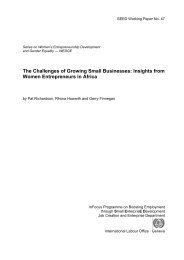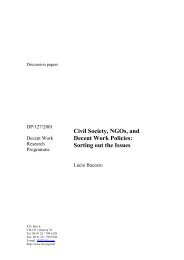manual: women workers' rights and gender equality - International ...
manual: women workers' rights and gender equality - International ...
manual: women workers' rights and gender equality - International ...
You also want an ePaper? Increase the reach of your titles
YUMPU automatically turns print PDFs into web optimized ePapers that Google loves.
Step 5<br />
• At the end of this session, emphasize that in terms of <strong>equality</strong> everyone should have equal access<br />
<strong>and</strong> control over resources <strong>and</strong> benefits. It is important to draw a clear conclusion from this <strong>and</strong> the<br />
previous exercises on <strong>gender</strong> <strong>equality</strong> promotion. Summarize the key messages <strong>and</strong> illustrate the<br />
current imbalances between the workload, decision making power <strong>and</strong> income of <strong>women</strong> <strong>and</strong> men by<br />
showing the card with the weighting scales. Ask participants for other issues or fields where there are<br />
imbalances between the position of men <strong>and</strong> <strong>women</strong>.<br />
• In the round-up conclude that <strong>gender</strong> <strong>equality</strong> promotion leads to a higher quality of life for all.<br />
Gender <strong>equality</strong> refers to the equal <strong>rights</strong>, responsibilities, opportunities, treatment <strong>and</strong><br />
valuation of <strong>women</strong> <strong>and</strong> men in employment <strong>and</strong> in the relation between work <strong>and</strong> life. Gender<br />
<strong>equality</strong> includes:<br />
• the same human <strong>and</strong> workers’ <strong>rights</strong><br />
• equal value <strong>and</strong> fair distribution of:<br />
- responsibilities <strong>and</strong> opportunities<br />
- workload, decision making <strong>and</strong> income<br />
Notes for the trainer<br />
The following are the most important points in this session:<br />
1. Men <strong>and</strong> <strong>women</strong> should have equal access to resources, i.e. equally use them<br />
2. Men <strong>and</strong> <strong>women</strong> should have the same decision making power, i.e. both should decide how to use a<br />
resource<br />
According to the Oxford Dictionary a resource is a stock or supply of materials or assets. In other words:<br />
a resource is everything people need to carry out an activity like: tools to work on the l<strong>and</strong>, food to eat,<br />
education to learn, etc. Persons are also regarded as resource, because a friend or a community<br />
member can be very useful in, for instance, solving a problem or getting information. Organizations can<br />
be a resource in the sense that they can provide technical inputs or give credit, for example. Resources<br />
are used by people.<br />
People can enjoy a resource, meaning that they get a benefit from it. A benefit is something that helps<br />
people or gives them an advantage, like an income, food for eating or sale, knowledge, power, status or<br />
recognition.<br />
The welfare of the family will improve if more benefits come to the family. Emphasize that not<br />
only money but also knowledge will improve the welfare of the family. If you know more you have<br />
easier access to different kind of services for instance, just because you know where to go.<br />
During the discussion after placing all cards under the man, woman or couple, the participants have to<br />
find out whether men <strong>and</strong> <strong>women</strong> have equal access to the resources. The access to most of the<br />
resources is the same to man <strong>and</strong> woman; this means that a lot of cards will be placed under the<br />
couple. For instance: both man <strong>and</strong> woman can switch the light on <strong>and</strong> off so they have equal access<br />
to electricity.<br />
However, it can happen that men <strong>and</strong> <strong>women</strong> both have access to a resource but they do not<br />
equally benefit from it because the decision making power is with the other person. For instance, a<br />
woman is looking after the livestock, so she is doing the work but often it is the man who decides<br />
to sell a cow <strong>and</strong> sometimes he is the one who gets the money <strong>and</strong> decides how to spend it.<br />
This shows that using the resource or providing the labour for the resource does not automatically<br />
mean that that person is also controlling the resource (meaning: to decide what to do with the<br />
resource). You can use this example to start the discussion <strong>and</strong> ask the participants to think of<br />
other similar situations.<br />
44

















